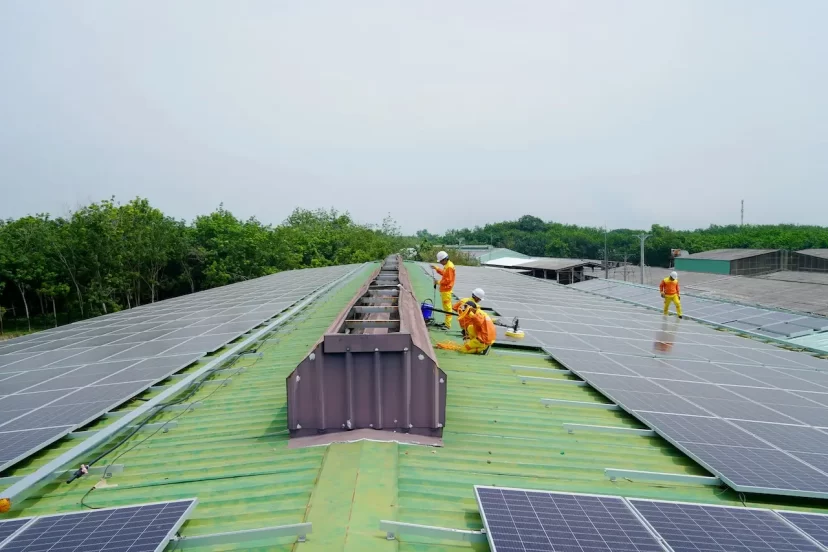Solar Energy Generation and Its Potential
We may earn a commission for purchases made using our links. See our disclosure to learn more.
At the heart of solar energy generation are photovoltaic cells, devices designed to convert solar radiation directly into electricity. When light strikes the junction between a metal and a semiconductor, such as silicon, or the junction between two different semiconductors, a small electric voltage is generated. This phenomenon, known as the photovoltaic effect, forms the basis for harnessing sunlight as a renewable energy source.
Despite their innovative design, the power output of an individual photovoltaic cell remains relatively low, typically around two watts. However, by connecting large numbers of these cells together in solar panel arrays, it is possible to generate hundreds or even thousands of kilowatts of electric power. This principle is at work in solar panel power plants, as well as in household arrays that aim to offset or replace conventional electric supply.
Energy Efficiency of Most Present-day Photovoltaic Cells
There is a practical consideration though; the energy efficiency of most present-day photovoltaic cells is only about 15 to 20 percent. Given that solar radiation’s intensity is inherently low, substantial and costly assemblies of such cells are needed to generate even moderate amounts of power. Nevertheless, the fact that the cost of producing solar panels has steadily decreased over the years has served to make solar power an increasingly feasible option.
Beyond their use in large-scale energy generation, photovoltaic cells also find applications in smaller, low-power devices. A pocket calculator or a wristwatch, for instance, can harness enough energy from sunlight or artificial light to operate effectively. More significant units power water pumps and communications systems in remote areas, ensuring that these essential services remain uninterrupted. Additionally, they have become a staple in weather and communications satellites, guaranteeing a reliable source of power in the unforgiving vacuum of space.
New Technology: Thin-film Solar Cells
The advent of new technologies, such as thin-film solar cells, has expanded the possibilities for solar energy utilization. Building-integrated photovoltaics, for instance, allow homeowners and businesses to install solar panels on their rooftops, significantly augmenting the conventional electric supply. This technology has enabled an average output that was previously unattainable, transforming homes and offices into micro power plants.
Another innovative approach in solar energy generation is concentrated solar power plants, which utilize concentrating collectors to focus sunlight received from a wide area onto a small, blackened receiver. This technique increases the light’s intensity, thereby producing high temperatures. Arrays of carefully aligned mirrors or lenses can focus sunlight sufficiently to heat a target to temperatures of 2,000 °C (3,600 °F) or more. This heat can then operate a boiler, in turn generating steam for a steam turbine electric generator power plant.
Solar energy’s potential extends beyond electricity generation. In some countries, solar power aids in producing salt from seawater through evaporation. Solar-powered desalination units convert salt water into potable water, leveraging the Sun’s energy to heat, either directly or indirectly, and drive the desalination process.
Hydrogen As An Energy Source
Recently, solar technology has also been explored in the production of hydrogen as an alternative energy source. Mimicking photosynthesis, scientists developed artificial leaves, silicon-based devices that use solar energy to split water into hydrogen and oxygen, leaving virtually no pollutants. Although these devices need further refinement to improve their efficiency and cost-effectiveness for industrial use, they represent a significant stride towards a clean, renewable future.
Today, the advent of portable solar power generators adds another layer of flexibility to solar energy. These devices can store solar energy, providing a reliable and renewable source of power for outdoor activities, emergencies, or any situation where traditional power sources are unavailable. Combining the portability of these generators with the versatility of a generator solar system presents an exciting prospect for both urban and rural dwellers alike.
Scalability of Solar Energy
The scalability of solar energy generation is one of its most significant advantages. On one end of the spectrum, we find compact photovoltaic cells powering low-energy devices like watches and calculators. On the other end, we see colossal solar panel power plants, transforming vast amounts of sunlight into usable electricity. The scope for scalability extends to individual households as well. With the development of small-scale, affordable solar panels, households, and businesses can become active participants in energy generation.
Moving on, new developments in storage technologies have ushered in the era of portable solar power generators. These gadgets have the capability to gather and reserve solar power when the sun is at its peak, and they can dish it out later when needed. This not only ensures a reliable source of power whenever we need it, but it also expands the potential applications of solar energy. This makes solar energy a critical asset, especially in remote or off-the-grid locations.
Solar Energy in Education
The exploration of solar energy also paves the way for educating future generations about renewable energy. Schools around the world are starting to include solar energy and other forms of renewable energy in their curriculum, cultivating an understanding of sustainability among students from a young age. Children are learning how solar panels harness sunlight to create electricity, witnessing real-life applications of scientific principles they learn in textbooks. Some schools have even installed their own solar power generators as part of their infrastructure, allowing students to see first-hand the operation and benefits of these systems.
This educational impact of solar energy fosters a generation conscious about energy conservation, effectively turning today’s learners into tomorrow’s green energy champions. This aspect of solar energy may not be about power generation directly, but the impact it holds for the future is indeed powerful.
If you learned something new about Solar Energy Generation, visit our more informative pieces on Solar Power Knowledge Hub!




